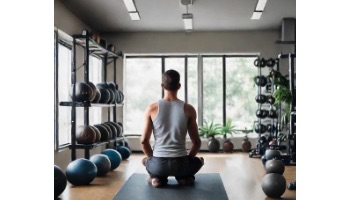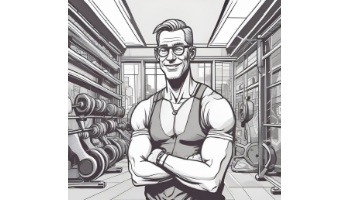 I’m a little nervous. Not because of the weight that I am about to throw over my head, but because I am being paraded in a onesie (a.k.a. singlet) in front of a crowd. I’m participating in an Olympic lifting event and the competitors are heading out together on the platform for a round of applause. It’s not so much the principle of being seen in a singlet that bothers me, it’s the fact that at six foot three inches tall, it was difficult to find one that is form fitting but not giving me a wedgie. I’ll survive this minor embarassment. Later though, I will end up having a conversation with a client about this whole situation that has something very revealing (pun intended) to tell us about our assumptions around body types, fitness, and athletic performance: The idea that ‘fit’ looks a certain way is a lie.
I’m a little nervous. Not because of the weight that I am about to throw over my head, but because I am being paraded in a onesie (a.k.a. singlet) in front of a crowd. I’m participating in an Olympic lifting event and the competitors are heading out together on the platform for a round of applause. It’s not so much the principle of being seen in a singlet that bothers me, it’s the fact that at six foot three inches tall, it was difficult to find one that is form fitting but not giving me a wedgie. I’ll survive this minor embarassment. Later though, I will end up having a conversation with a client about this whole situation that has something very revealing (pun intended) to tell us about our assumptions around body types, fitness, and athletic performance: The idea that ‘fit’ looks a certain way is a lie.
Thankfully, It’s Not A Fashion Show
I’m tall and I weigh about one hundred ninety pounds (89kg weight class). In normal, everyday clothing I can usually fit into a medium; occasionally a large. My singlet is a double XL. I have to go up three sizes so that I won’t be reminiscent of one of those cartoons where someone has their lower lip stretched up over their face. Of course, there is a trade-off that comes from going up three sizes, which is that my singlet is too baggy. So, when I got to the meet described above, it was in a singlet that just barely stays out of my ass-crack while bagging out around the midsection. Not entiely flattering, but I was determined to lift anyway—spectators be damned.
Why is it so hard to find a singlet that fits well? The short answer is that my body is not the ideal for the sport. Olympic weightlifters need to be very mobile because they have to squat very, very low and it’s easier to do that if you have shorter legs relative to your torso. Tall people tend to have long legs, like me, so that sucks. Also, since Olympic lifting is about getting a weight from the floor to overhead, it helps if overhead isn’t too terribly far from the floor. Finally, people who spend a lot of time lifting weights tend to develop larger than average muscles, so they fill out their singlets better than I with my string bean physique. In short (pun intended), tall and skinny isn’t what singlet designers have in mind.
Given the discrepancy between ideal lifting physique and me, one might question how I ended up there in the first place, and that brings us back to my client, who happened to be in the crowd that day. When I and my fellow competitors came out on stage together, sporting our super tight singlets, he noticed that there was an entire spectrum of body types, from me on the tall skinny side, to the shorter and heavier, to the highly muscular, to the in-betweens. In fact, we were a pretty good cross-section of body diversity in everyday life. What got him thinking was the fact that how we looked did not seem to correlate neatly with his expectations about how we would perform. He thought, quite naturally, that the best lifters would be the muscular people of medium height—the athletic type who fits nicely into a singlet. But that wasn’t the case. Over the course of the day he saw that it was almost impossible to predict who would perform best based solely on how they looked. Why is that?
It’s Not What You’ve Got, It’s How You Use It
The answer to this question takes a little deconstructing. Let’s start with what is universal. Olympic lifting is a very technique heavy sport. You’re trying to take a weight from the floor all the way up to overhead in either one movement (the snatch) or in two movements (the clean and jerk). When the weight in question is a couple of hundred pounds you don’t want to do this by wrenching and jerking and twisting. You have to employ a very specific technique with very little margine for error. So, right off the bat, lifters set themselves apart through their skill, which is not necessarily connected to how they look. On my lifting day, there were some very normal looking people with great technique and some very jacked people with marginal technique. The people with good technique did as well or better than the ones with the bod.
Another deeper topic (keep the puns coming) is the nature of muscles. In pop culture we tend to equate the strength of muscles with their size, but that isn’t the whole picture. Muscular strength is not just about the size of muscle fibers, it’s also about the number of fibers that you can activate for a task. This is known as motor unit recruitment. Motor units are bundles of muscle fibers that are activated by a nerve signal. One of the ways that your body regulates how much strength to produce in any given task is by regulating how many of these motor units get turned on. When you train for strength by lifting heavier loads, one of the things you are doing is teaching the body to get more motor units involved. The key concept here is that these are motor units for muscles that you already have. It’s not just about getting more muscle or even making bigger muscle, it’s about getting more of what you’ve got to wake up and do its thing.
RELATED: How To Tell The Difference Between Strength And Endurance
Finally, Olympic lifting is about power. Power, in a nutshell, is how quickly you can get your muscles to apply force. A good way to understand the difference is to think about runners. Sprinters, for example, want to go as fast as possible so when they run they try to produce maximum power from the legs. Long distance runners, on the other hand, want to go for a long time and they don’t need to go as quickly, so they don’t produce as much power from their legs. Once again, the way a person’s muscles look may not be an indicator of how powerful they are. Large muscles can be slow and small muscles can be powerful, it just depends.
So far, it sounds a lot like physique has nothing to do with performance, but of course our practical experience is enough to tell us that this can’t be entirely true. There aren’t a lot of ninety eight pound linebackers or five foot tall basketball players out there, the same way there aren’t a lot of six foot three Olympic lifters to make passable singlets for. Well, this is where things get really interesting because it lays bare a very insidious problem about how society warps our sense of body image.
Enough About Me, Let’s Talk About What You Think About Me
So we seem to be sitting on a contradiction. On the one had, performance goes beyond looks. On the other, there are some characterstics that don’t go well with certain sports. So which is it? Does physique matter or not? The answer is, it depends on what level you are performing at. The meet that I participated in was a small, local one in Brooklyn comprised mostly of amateurs. We lift for fun and for fitness, not to make the Olympic team. Thus, we don’t have to be the ideal. Having the ideal body doesn’t start to become critical until you get closer to the top of the heap. If you want to play in the NBA you better be tall. If you just want to play a pick-up game in the park, it’s not that critical. If you want Olympic gold in weightlifting, you better have the right proportions. If you want to compete in a local meet, you can be a tall bean pole in an ill-fitted singlet.
The nuance here is to understand that while you might need to be an outlier to be at the very top of a profession—like in the seven foot tall range to play in the NBA—that doesn’t mean you have to be like that to be good at all. Put another way, just because you’re not Lebron James doesn’t mean you’re terrible at basketball.
In our society we tend to pay attention to the outliers. As evolutionary biologists have pointed it, this may be because it’s a good survival strategy. You want to notice things that are novel or abnormal because they might be dangerous. Unfortunately in the health, beauty, and fitness arena this predisposition draws our attention towards the abnormal with negative consequences. The covers of magazines, the models for advertising and fashion, the stars of movies and television all tend to be people gleaned from the tops of the talent pool. The sports heroes are the athletically freaky with the biggest, fastest, strongest bodies. Advertising and fashion and television and the silver screen are populated with people that are exceptionally pretty, slim, with great hair, and who age well. We look to these outliers as a model for what we should be, forgetting that these people are amongst the elite in what they do and therefore need to be exceptionally talented. They need to have the advantages that can push them over the top when they are competing at the highest levels of their profession.
Strive For Better, Not Elite (Unless You Happen To Be Elite)
So the moral of the story is that while it is great to strive for improvement, remember to honor who you are. The best of the best can certainly be great role-models. It’s also reasonable to be inspired by them and to try to emulate the things that make them successful. However, we have to be able to properly contextualize their abilities and our own. You don’t have to be on the cover of Men’s/Women’s Health to be in good shape. You don’t have to be running marathons to be a good runner. You don’t have to fit perfectly into a singlet to be a good Olympic lifter. And you don’t have to look like a model to be fit, healthy, and attractive. Most of us simply won’t ever be in these elite catagories. That doesn’t mean though that we aren’t in good enough shape, nor does it mean that we can’t consistently improve, striving all the time to be just a little bit better.


